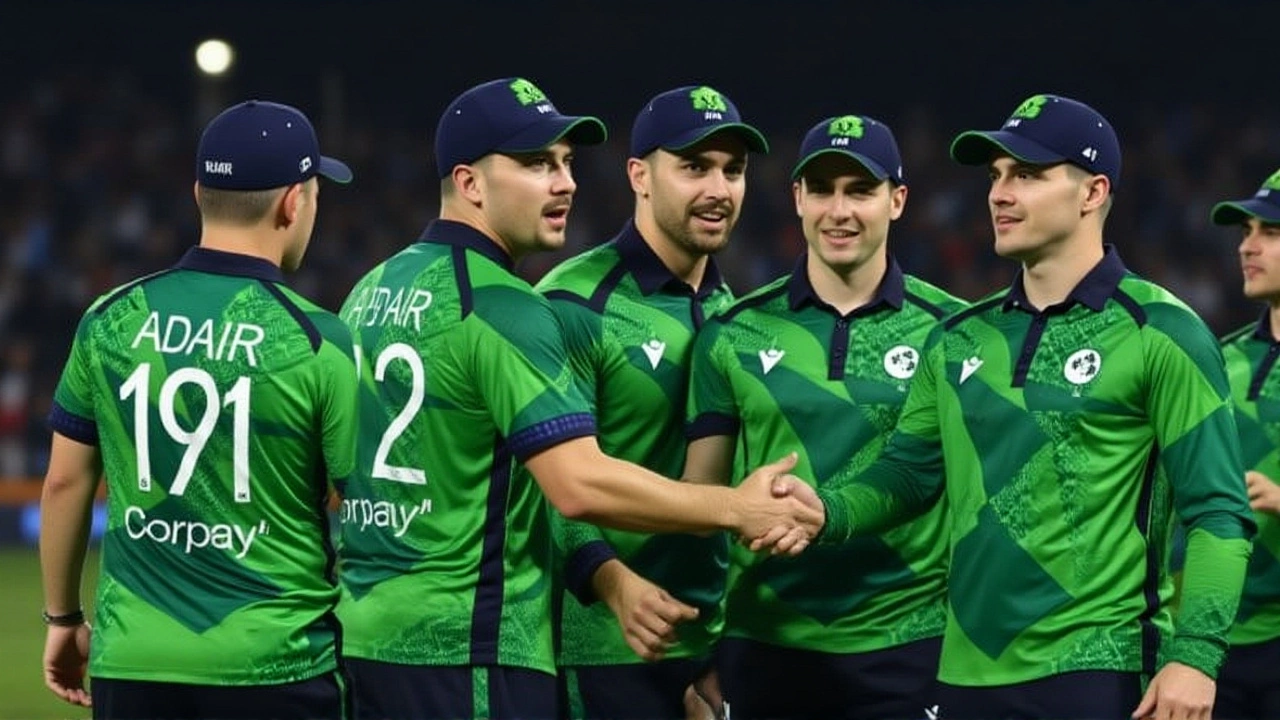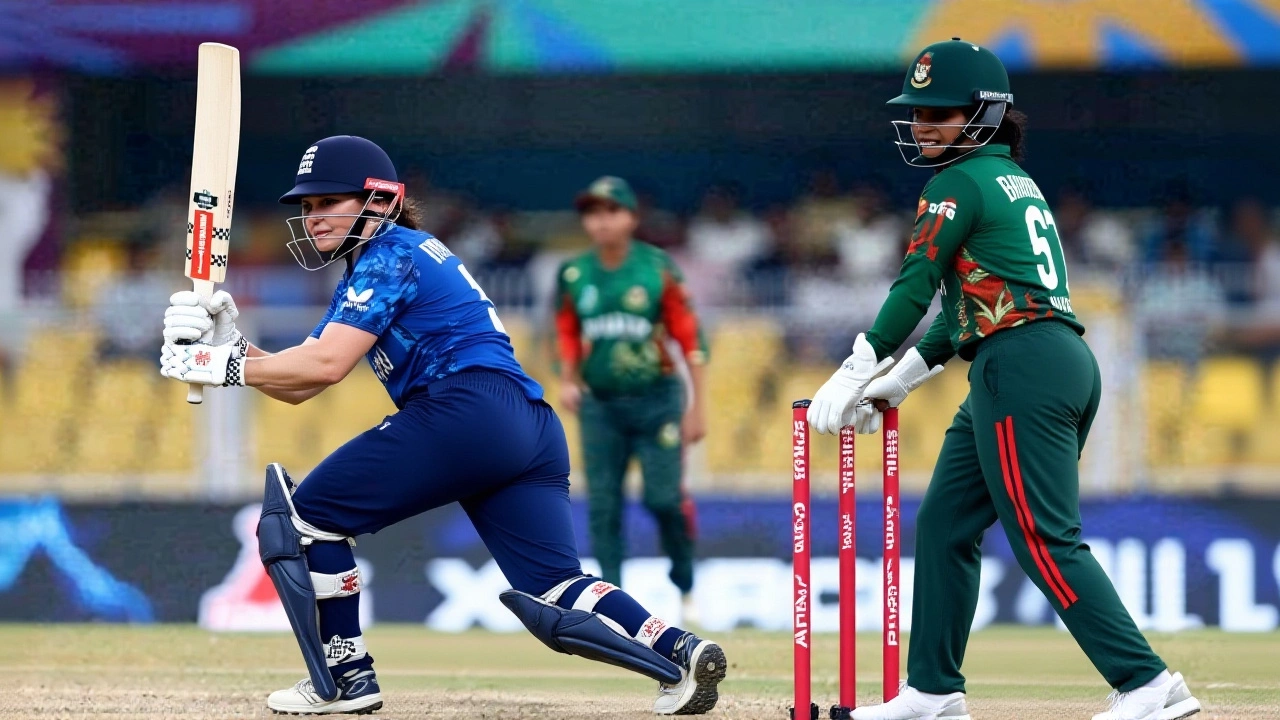When Heather Knight stepped up to the crease with England Women needing 79 runs off 108 balls, the pressure was suffocating. The Barsapara Cricket Stadium in Guwahati was electric — 40,000 fans on their feet, the air thick with the scent of incense and sweat. And then, in the 46th over, she drove Bangladesh Women's final bowler through cover for four. The crowd erupted. England had done it: 182 for 6 in 46.1 overs. A win. A statement. And Knight, unbeaten on 79, had carried them home.
Chasing History in the Rain-Soaked North
It was a match that didn’t follow the script. England Women, after winning the toss and choosing to field, watched Bangladesh Women scramble to 178 in 49.4 overs — a total that looked manageable on paper, but turned treacherous under pressure. The pitch, a slow, low one, had swallowed pace and rewarded patience. And Bangladesh Women had found their rhythm. Sobhana Mostary (60 off 100) anchored, while Rabeya Khan exploded with 43 off just 27 — six fours and a six that cleared the midwicket fence like a cannonball. Their 17 extras — 15 wides alone — were a sign of nervousness, but also of resilience.England’s reply began with promise. Nat Sciver-Brunt played her usual aggressive innings, smashing 32 before falling in the 14th over. Then came the collapse. 69 for 4. 78 for 5. 103 for 6. The crowd held its breath. The scoreboard had gone quiet. The pressure was mounting. Heather Knight, the captain, was now the only recognized batter left. She had been quiet — 27 runs off 72 balls — but never rushed. She was biding time. Waiting for the right moment. And when Charlie Dean joined her at the crease, the pair didn’t panic. They built. They rotated. They punished the bad balls. Their 50-run stand came in 68 balls — the kind of partnership that wins World Cups.
Spin, Sweat, and a Three-Wicket Haul
Behind the scenes, England’s bowlers had done the heavy lifting. Sophie Ecclestone was the architect of Bangladesh’s downfall, claiming 3 for 25 with her left-arm orthodox spin, tying up the middle overs with surgical precision. Charlie Dean, Alice Capsey, and Linsey Smith each took two wickets, turning the pressure into dismissals. Even Lauren Bell chipped in with the vital wicket of Supta, who had looked dangerous at 30 off 52.On the other side, Fahima Khatun was Bangladesh’s lone warrior. Three wickets for 25 runs — a masterclass in line and length. But with no support, her brilliance was lost in the noise. The fielding, too, let them down. Three dropped catches — two off Knight — and a misfield that allowed a crucial boundary in the 42nd over. In World Cup cricket, those moments don’t just cost runs. They cost games.
Run Rate Rises: England Overtake India at the Top
This win didn’t just give England four points — it changed the tournament’s entire landscape. India Women, who had been sitting pretty at the top after two wins, now found themselves tied on points. But here’s the twist: England’s net run rate of +0.98 now edges out India’s +0.72. It’s not just about wins anymore. It’s about margins. About how you win. And England? They’re winning by the slimmest of margins — and it’s adding up.Australia Women, meanwhile, sit in third with three points, still needing to prove they can handle pressure like England. Bangladesh? They’re fourth. And despite the valiant effort — Rabeya’s blitz, Fahima’s spell — they’re still searching for that signature win. The question now isn’t whether they can compete. It’s whether they can close.

What’s Next? A Tightening Race
England’s next match is against South Africa in Delhi — a fixture that could cement their status as genuine title contenders. Knight, who has now scored 156 runs in two innings, is in the form of her life. Ecclestone is bowling with a calmness rarely seen in World Cups. And the middle order? They’ve shown they can survive. But here’s the thing: the margin for error is gone. One slip, one dropped catch, one misjudged review — and the whole thing unravels.For Bangladesh, the road gets harder. Next up: a clash with New Zealand. They’ve shown flashes of brilliance. But in knockout cricket, flashes aren’t enough. They need consistency. They need to stop losing wickets in clusters. And they need to believe — not just in their ability, but in their right to be here.
Behind the Scenes: The Umpires and the Reviews
The match was officiated by a strong team: Claire Polosak and Vrinda Rathi as on-field umpires, with Gayathri Venugopalan as TV umpire. England used two DRS reviews — one to challenge Knight’s lbw in the second over (upheld), another to dispute Dunkley’s dismissal in the 18th over (struck down, umpire’s call). Both decisions were correct. But they mattered. Because in a match decided by 4 wickets and 11 balls, every decision counts.Frequently Asked Questions
How did Heather Knight’s innings compare to her previous World Cup performances?
Knight’s 79* was her highest score in a Women’s World Cup since 2017, and her first fifty in this tournament. Her strike rate of 71.17 was calculated under immense pressure — significantly lower than her usual 85+, showing she adapted to the conditions. She now has 156 runs in two matches, the most by any England batter in this World Cup so far.
Why was Bangladesh’s 178 considered a competitive total?
On a slow, low pitch at Barsapara, 178 was competitive because spinners dominated and boundaries were hard to come by. Only two teams in the tournament have chased higher totals successfully — both on faster pitches. Bangladesh’s extras (17) were a liability, but their middle-order aggression — especially Rabeya Khan’s 43 off 27 — showed they could accelerate when needed.
What impact does this result have on England’s chances of reaching the final?
With four points and the best net run rate in the group, England are now clear favorites to finish top. Their next two matches — against South Africa and New Zealand — are winnable, and if they win at least one, they’ll almost certainly qualify directly. Australia, with three points, need to win all remaining games and hope England slip up.
How did the pitch conditions influence the match outcome?
The Barsapara pitch offered little pace and variable bounce, favoring spinners and disciplined batting. The first innings saw only 14 boundaries — unusually low for a T20-style ODI. England’s ability to rotate strike and avoid risky shots in the middle overs was key. Bangladesh, despite early aggression, couldn’t sustain momentum under pressure — a hallmark of the surface.
Who were the key players outside of Knight and Ecclestone?
Charlie Dean’s 17 not out in the final partnership was crucial — she held the crease while Knight accelerated. For Bangladesh, Fahima Khatun’s 3 for 25 was the best bowling figures of the tournament so far. Also, Rabeya Khan’s 43 off 27 showed that even in defeat, Bangladesh have explosive talent capable of changing games.
What does this win mean for women’s cricket in India?
The sell-out crowd in Guwahati — over 40,000 — proves that women’s cricket has massive appeal in India, even when the home team isn’t playing. The atmosphere, the chants, the media coverage — it’s all growing. This match, between two non-Indian teams, drew more viewers than most IPL games last season. It signals a new era: women’s cricket isn’t just growing — it’s commanding attention.

